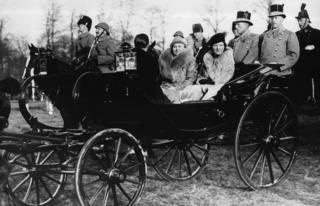Dutch queen ‘considered Nazi swap for royals’
 Image copyright Keystone/Getty
Image copyright Keystone/Getty As World War Two neared an end, Dutch Queen Wilhelmina sought a deal with the Nazis to save the Belgian royal family, according to the newly published diaries of her foreign minister.
By late March 1945, Belgium and the southern Netherlands had been liberated but Belgium’s King Leopold III was being held captive in Austria.
Leopold’s mother feared that the Nazis would murder the family.
So Wilhelmina considered a possible exchange, a Dutch historian has said.
She asked her foreign minister in exile in London, Eelco van Kleffens, to “sound out” via the Vatican whether high-ranking Nazis could be offered an escape route in return for the Belgian royal family’s release, says Michael Riemens who has just published the minister’s diaries.
The revelations shed further light on how top Nazis were trying to negotiate their escape from Europe in the dying days of the war. Many high-ranking Nazis were successfully spirited away to Latin America, including Adolf Eichmann, Josef Mengele and Klaus Barbie.
“Until now we have never heard of the Dutch playing a role,” says Mr Riemens, whose book, Majesty, You don’t know real life, features the diaries.
What happened in March 1945?
By this time, Queen Wilhelmina had returned to the liberated part of the Netherlands and in late March travelled to Brussels to see Belgium’s queen mother, Elisabeth, and the king’s brother, Charles.
Leopold III, who had controversially stayed in Belgium during the Nazi occupation, was moved by the Nazis to Austria in 1944 as the allies advanced and was detained there with his second wife, Lilian, Princess of Réthy, and his children Joséphine-Charlotte, Baudouin and Albert.
Image copyright Keystone/Getty
His mother told Wilhelmina she was very worried the Nazis would kill the king and his children, Mr Riemens says. As Leopold’s brother had no children, she would have feared for the future of the Belgian royal family.
The historian quotes a letter written by the Dutch queen to Britain’s King George VI, and refers to the Belgian queen mother mentioning a possible exchange:
“She volunteered in confidence that the Germans had been approached through the Red Cross about allowing at least the children to go to Switzerland. The Germans answered that it would be possible for the children and Leopold to go to Switzerland if the Swiss extended similar facilities to the Nazi chiefs”.
How did George VI respond?
Mr Riemens told the BBC he found the reaction of the king to the Dutch queen’s letter in the archives of the cabinet of the queen.
26 March 1945
“Dear cousin Wilhelmina… I am very interested to hear that cousin Elisabeth spoke to you about Leopold and the children. As you say, we can never strike that bargain with the Germans but I feel there must be some other way of getting him free.”
Image copyright Universal History Archive
On the same day, Wilhelmina talks to Eelco van Kleffens and, according to Mr Riemens, on 29 March he speaks to Pope Pius XII’s internuncio to The Hague (ambassador) in London and writes in his diary:
“In the afternoon the internuncio came at my request. I had been instructed by her majesty to ask him to share with the Pope that the king of Belgium and his children were in danger of being killed unless the highest Nazi chiefs could get asylum in a safe country. This information in the hope that the Pope would do something.”
What happened next?
According to Michael Riemens, the Dutch envoy to the Holy See sends a report in April about papal support for the Dutch proposal, and that report is passed on by the Dutch ambassador to London, Michiels van Verduynen.
That report is missing from the archive, and the historian says the queen was known to have destroyed several reports.
A note dated 21 May 1945 in the queen’s handwriting does state her special thanks for the Pope’s action.
“It means the Pope did act, but there’s no proof,” he says.
Image copyright Getty Images
The Vatican has for years come under pressure to open up its own secret archives from the war, and the Holy See said last month it would open up the files next year.
“I think the royals played a role through this contact with the Pope and all of a sudden we see a very different queen.”
Wilhelmina was highly regarded by the Dutch during the war for her morale-boosting radio broadcasts from exile in London. She was not only known to be anti-Nazi but she was also considered highly anti-Vatican.
“There is royalty in danger, a huge threat to the Belgian monarch, and she decides to try using the Pope,” says Michael Riemens.
Thousands of members of the Nazi SS were able to flee during the chaos at the end of the war, including many top-ranking officials.
But ultimately the Dutch queen’s intervention did not bring about the Belgian monarch’s release.
King Leopold was eventually freed weeks later as US forces advanced near Salzburg. Wilhelmina abdicated in 1948 and died in 1962.
Could King George have helped?
While George VI was close to Wilhelmina and the Dutch government in exile, it seems unlikely that he could have had any influence over this period at the end of World War Two.
“You can see George thinking, ‘I’ve got a very strong relative but what can I reasonably do?'” says Andrew Stewart, professor of modern conflict history at King’s College London.
“The allies had an avowed policy of unconditional surrender. If you are seen to negotiate for one figure, then why not for others?”
Queen Wilhelmina had no influence within allied command and George VI would have had to go through Winston Churchill and President Roosevelt for any request to have been made, he says.





